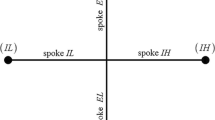Abstract
We examine the myopic price changes based on the inverse elasticity pricing rule for a multiproduct firm. By myopic, we mean ignoring that elasticity likely changes with price and that marginal cost likely changes with quantity. Unlike with a single product firm, constant demand elasticities and marginal cost do not cause the inverse elasticity rule to yield the profit-maximizing price change. The price change will be too large if the related products are complements which are relatively inelastic and too small otherwise. Importantly, whether non-constant marginal cost causes too large or too small, a price change is independent of whether the related products are substitutes or complements. Increasing marginal costs always causes too large an increase and decreasing marginal costs always causes too small an increase. While not providing a full characterization, we partially identify the net effects of allowing elasticities, cross-price elasticities, and marginal cost to be non-constant.
Similar content being viewed by others
Data availability
Not applicable.
Notes
Reibstein and Gatignon (1984) also include uncertainty and Tirole (1988) expresses (2) in terms of the price–cost margin as follows: \(\frac{{p}_{i}-{c}_{i}}{{p}_{i}}=\frac{-1}{{\varepsilon }_{ii}}-\sum_{j\ne i}\left({p}_{j}-{c}_{j}\right)\left(\frac{{\varepsilon }_{ji}}{{\varepsilon }_{ii}}\right)\frac{{q}_{j}}{{{p}_{i}q}_{i}}\). The expression in (2) is sometimes also referred to as the Niehans formula (Simon and Fassnacht 2019).
We recognize that altering these assumptions will lead to even more complex influences on the difference between myopic and optimal pricing. Yet, as our primary objective is to show how poorly the multiple product rule of thumb works compared to the single product rule of thumb, we leave these complexities aside.
The other marginal cost effect might also be called the margin effect, since it pertains to the price-marginal cost margin of the related product, (\({p}_{j}-{c}_{j}\)).
Tirole (1988) uses the example of each product being produced by a separate division of a profit-maximizing firm. For substitutes, the divisions are de facto competitors and must be given incentives to raise price to eliminate externalities between them. They must be given incentives to lower price if the divisions produce complements.
The relative quantities effect can be zero if, by chance, \({\varepsilon }_{ji}={\varepsilon }_{ii}\) since this will leave the relative quantities unchanged. This can only happen for complementary goods.
The net effect could be zero in the extremely unlikely case that all marginal costs and elasticities are constant, and all related products are complements to the priced product and where \({\varepsilon }_{ji}={\varepsilon }_{ii}\) for all of them.
References
Auer, J., and D. Papies. 2020. Cross-price elasticities and their determinants: a meta-analysis and new empirical generalizations. Journal of the Academy of Marketing Science 48: 584–605.
Besanko, D., and R. Braeutigam. 2020. Microeconomics. New York: Wiley.
Browning, E.K., and M.A. Zupan. 2020. Microeconomics: theory and applications. New York: Wiley.
Dranove, D., D. Besanko, M. Shanley, and S. Schaefer. 2017. Economics of strategy. New York: Wiley.
Fjell, K. 2003. Elasticity based pricing rules: a cautionary note. Applied Economics Letters 10 (12): 787–791.
Fjell, K., and D. Pal. 2019. On repeated myopic use of the inverse elasticity pricing rule. Economics Letters 175: 12–14.
Fjell, K., and D. Pal. 2021. Adjusted repeated myopic use of the inverse elasticity pricing rule. Journal of Revenue and Pricing Management 20: 1–7.
Krueger, M. 2009. The elasticity pricing rule for two-sided markets: a note. Review of Network Economics. https://doi.org/10.2202/1446-9022.1180.
Laitinen, E.K. 2009. From complexities to the rules of thumb: towards optimisation in pricing decisions. International Journal of Applied Management Science 1 (4): 340–366.
Monroe, K.B., and J.L. Cox. 2001. Pricing practices that endanger profits. Marketing Management 10 (3): 42.
Noreen, E. 1991. Conditions under which activity-based cost systems provide relevant costs. Journal of Management Accounting Research 3 (4): 159–168.
Parker, G., and M. Van Alstyne. 2005. Two-sided network effects: a theory of information product design. Management Science 51: 1494–1504.
Pindyck, R.S., and D.L. Rubinfeld. 2018. Microeconomics. London: Pearson.
Raubitschek, R.S. 1987. A model of product proliferation with multiproduct firms. The Journal of Industrial Economics 35 (3): 269–279.
Reibstein, D.J., and H. Gatignon. 1984. Optimal product line pricing: the influence of elasticities and cross-elasticities. Journal of Marketing Research 21: 259–267.
Schmalensee, R. 1978. Entry deterrence in the ready-to-eat cereal industry. The Bell Journal of Economics 9: 305–327.
Simon, H., and M. Fassnacht. 2019. Price management. Cham: Springer.
Tirole, J.T. 1988. The theory of industrial organization. Cambridge: MIT Press.
Acknowledgements
We are grateful to Sophie Maussen and anonymous reviewers for helpful comments.
Funding
The authors declare that no funds, grants, or other support were received during the preparation of this manuscript.
Author information
Authors and Affiliations
Contributions
The first draft of the manuscript was written by KF. Both authors have made substantial contributions to the analysis and interpretation of the results. Both authors have revised the manuscript critically for important intellectual content. Both authors have read and approved the final manuscript.
Corresponding author
Ethics declarations
Conflict of interest
The authors have no relevant financial or non-financial interests to disclose.
Additional information
Publisher's Note
Springer Nature remains neutral with regard to jurisdictional claims in published maps and institutional affiliations.
Rights and permissions
Springer Nature or its licensor (e.g. a society or other partner) holds exclusive rights to this article under a publishing agreement with the author(s) or other rightsholder(s); author self-archiving of the accepted manuscript version of this article is solely governed by the terms of such publishing agreement and applicable law.
About this article
Cite this article
Fjell, K., Heywood, J.S. Myopic use of the inverse elasticity pricing rule by a multiproduct firm. J Revenue Pricing Manag 23, 103–111 (2024). https://doi.org/10.1057/s41272-023-00436-8
Received:
Accepted:
Published:
Issue Date:
DOI: https://doi.org/10.1057/s41272-023-00436-8




